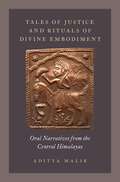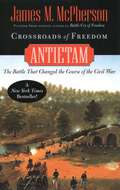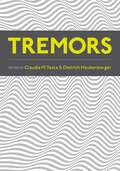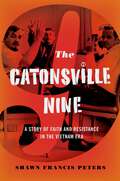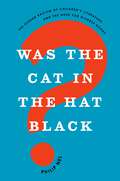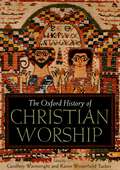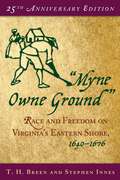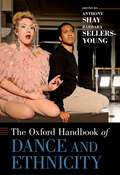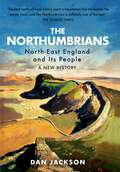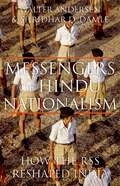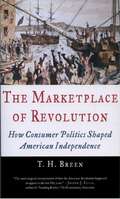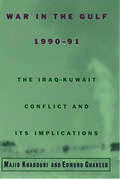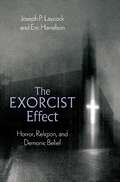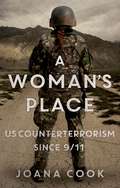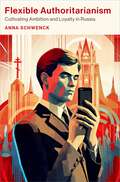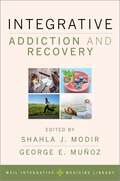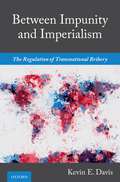- Table View
- List View
Tales of Justice and Rituals of Divine Embodiment: Oral Narratives from the Central Himalayas
by Aditya MalikBased on extensive ethnographic fieldwork conducted in the Central Himalayan region of Kumaon, Tales of Justice and Rituals of Divine Embodiment draws on oral and written narratives, stories, testimonies, and rituals told and performed in relation to the "God of Justice," Goludev, and other regional deities. The book seeks to answer several questions: How is the concept of justice defined in South Asia? Why do devotees seek out Goludev for the resolution of matters of justice instead of using the secular courts? What are the sociological and political consequences of situating divine justice within a secular, democratic, modern context? Moreover, how do human beings locate themselves within the indeterminateness and struggles of their everyday existence? What is the place of language and ritual in creating intimacy and self? How is justice linked to intimacy, truth, and being human? The stories and narratives in this book revolve around Goludev's own story and deeds, as well as hundreds of petitions (manauti) written on paper that devotees hang on his temple walls, and rituals (jagar) that involve spirit possession and the embodiment of the deity through designated mediums. The jagars are powerful, extraordinary experiences, mesmerizing because of their intensity but also because of what they imply in terms of how we conceptualize being human with the seemingly limitless potential to shift, alter, and transform ourselves through language and ritual practice. The petitions, though silent and absent of the singing, drumming, and choreography that accompany jagars, are equally powerful because of their candid and intimate testimony to the aspirations, breakdowns, struggles, and breakthroughs that circumscribe human existence.
Crossroads of Freedom: Antietam (Pivotal Moments in American History)
by James M. McPhersonThe Battle of Antietam, fought on September 17, 1862, was the bloodiest single day in American history, with more than 6,000 soldiers killed--four times the number lost on D-Day, and twice the number killed in the September 11th terrorist attacks. In Crossroads of Freedom, America's most eminent Civil War historian, James M. McPherson, paints a masterful account of this pivotal battle, the events that led up to it, and its aftermath. As McPherson shows, by September 1862 the survival of the United States was in doubt. The Union had suffered a string of defeats, and Robert E. Lee's army was in Maryland, poised to threaten Washington. The British government was openly talking of recognizing the Confederacy and brokering a peace between North and South. Northern armies and voters were demoralized. And Lincoln had shelved his proposed edict of emancipation months before, waiting for a victory that had not come--that some thought would never come. Both Confederate and Union troops knew the war was at a crossroads, that they were marching toward a decisive battle. It came along the ridges and in the woods and cornfields between Antietam Creek and the Potomac River. Valor, misjudgment, and astonishing coincidence all played a role in the outcome. McPherson vividly describes a day of savage fighting in locales that became forever famous--The Cornfield, the Dunkard Church, the West Woods, and Bloody Lane. Lee's battered army escaped to fight another day, but Antietam was a critical victory for the Union. It restored morale in the North and kept Lincoln's party in control of Congress. It crushed Confederate hopes of British intervention. And it freed Lincoln to deliver the Emancipation Proclamation, which instantly changed the character of the war. McPherson brilliantly weaves these strands of diplomatic, political, and military history into a compact, swift-moving narrative that shows why America's bloodiest day is, indeed, a turning point in our history.
Tremors
by Claudia M. Testa, Dietrich HaubenbergerTremor is the most common movement disorder. The breadth of work remaining in tremor pathophysiology, etiology and treatment development does not render the area intractable; on the contrary, this is a dynamic, rich research area sure to continue its rapid growth. In Tremors, experts in the field come together to discuss the underpinnings of neurological tremors and recent clinical findings in treatment models. This volume is broken into the following sections: ? "Tremor Foundations" presents work across research modalities, providing an overview on the underpinnings of tremor as symptom and disease. Recent developments in the understanding of tremor pathology, pathophysiology, and genetics, aided by groundbreaking discoveries using neuroimaging techniques, allow glimpses into future breakthroughs to come. ?"The Family of Tremors" presents the full extended range of tremor presentations, spanning isolated tremors, tremor as one of several features of a neurological disorder, and other hyperkinetic movement phenotypes commonly referred to, mimicking or framed as tremors. ?"Tremor in the Clinic" reviews the growing knowledge range of clinical topics in tremors. Advances in assessing tremor bring pathophysiology concepts into clinical use, opening an active era in new therapeutic development. Clinical researchin tremors also now encompasses more holistic treatment approaches, novel treatment modalities, and diversity and inclusivity, all areas likely to feed back into basic etiology and pathophysiology research of this common movement disorder. Tremors will prove to be a useful text for practicing clinicians, students and researchers focusing on movement disorders, and those living with tremor who want to learn more about their condition.
The Catonsville Nine: A Story of Faith and Resistance in the Vietnam Era
by Shawn Francis PetersIn the spring of 1968, a group of Catholic antiwar activists barged into a draft board in suburban Baltimore, stole hundreds of Selective Service records, and burned the documents in a fire fueled by homemade napalm. The bold actions of the ''Catonsville Nine'' quickly became international news, and they remained in the headlines throughout the summer and fall of 1968, when the activists were tried in federal court. Shawn Francis Peters tells the fascinating story of this singular witness for peace and social justice.
Strategic Workforce Planning: Best Practices and Emerging Directions (The Society for Industrial and Organizational Psychology Professional Practice Series)
by Marc Sokol and Beverly TarulliIndustrial-organizational psychologists increasingly advise organizations on talent planning, executive succession, workplace design, and better ways to ensure the future supply of talent: a suite of practice areas that comprise strategic workforce planning (SWP). This volume provides an overview of SWP, covering best practices across organization types, geographies, and methodologies, and addressing new directions in the field. Contributors share case examples and experience-based insights, spanning the evolution of SWP, best practices for analytics and consulting, maturity models, how SWP can be practiced in large companies inside and outside the United States, in high- and low-growth environments, and when to organize around planning for future tasks vs planning for future roles. As well as discussing changes in the workforce and workplace due to global disruptions like the COVID-19 pandemic and the impact of quickly evolving technologies, this book re-examines what SWP is and can be, how it is conducted, and what impact it can have on individual organizations and beyond.
Psychiatric Neuroethics: Studies in Research and Practice (International Perspectives in Philosophy and Psychiatry)
by Walter GlannonAdvances in psychiatric research and clinical psychiatry in the last 30 years have given rise to a host of new questions that lie at the intersection of psychiatry, neuroscience, philosophy and law. Such questions include: -Are psychiatric disorders diseases of the brain, caused by dysfunctional neural circuits and neurotransmitters? -What role do genes, neuro-endocrine, neuro-immune interactions and the environment play in the development of these disorders? -How do different explanations of the etiology and pathophysiology of mental illness influence diagnosis, prognosis and decisions about treatment? -Would it be rational for a person with a chronic treatment-resistant disorder to request euthanasia or assisted suicide to end their suffering? -Could psychiatric disorders be predicted and prevented? Psychiatric Neuroethics explores these questions in a comprehensive and systematic way, discussing the medical and philosophical implications of neuroscience and the Research Domain Criteria (RDoc) in the fields of psychiatry and mental health. It examines the extent to which circuit-based criteria can offer a satisfactory explanation of psychiatric disorders and how they compare with the symptom-based criteria of the Diagnostic and Statistical Manual of Mental Disorders (DSMV). This book will be of interest to a multidisciplinary audience, including psychiatrists, neurologists, neurosurgeons, philosophers, psychologists and legal theorists.
America's Scientific Treasures: A Travel Companion
by Brenda H. Cohen Stephen M. CohenWhether you are planning a road trip or looking to engage with history from the comfort of your couch, the second edition of America's Scientific Treasures is sure to satisfy your craving for scientific and technologic history. Stephen M. Cohen and Brenda H. Cohen, a mother-son pair, take readers through countless museums, arboretums, zoos, national parks, planetariums, natural and technological sites, and the homes of a few scientists in this exciting volume. The two combine their expertise in chemistry and history, making this an educational travel guide for science and technology enthusiasts. The book is split into nine geographic regions and organized by state, and it includes how to get to each place, whom to contact, whether it is handicapped-accessible, and even where you can grab a bite to eat nearby. Cohen and Cohen provide the history and significance of each location, plus they offer images for notable locations like the African Savanna at the San Francisco Zoo & Gardens and the Smithsonian Arctic Studies Center in the Anchorage Museum. The resulting book is a navigable travel guide perfect for any science or technology enthusiast. So, what are you waiting for? Let's take a journey through the history of American sciences and engineering.
Business and the Roberts Court
by Jonathan H. AdlerIn recent years, the Supreme Court appears to have taken a greater interest in "business" issues. Does this reflect a change in the Court's orientation, or is it the natural outcome of the appellate process? Is the Court "pro-business"? If so, in what ways do the Court's decisions support business interests and what does that mean for the law and the American public? Business and the Roberts Court provides the first critical analysis of the Court's business-related jurisprudence. In this volume, prominent academics examine the Roberts Court's handling of business-related cases, through a series of empirical and doctrinal analyses. Issues covered include securities law, antitrust, labor law, preemption, and environmental law, among others. Business law and regulatory cases touch on many important legal doctrines and can have far-reaching effects. Understanding the bases upon which the Supreme Court decides business-related cases is of tremendous importance to practitioners and academics. It can also further greater understanding of one of the nation's most important government institutions. These issues are of interest to academics, but also of practical importance to Supreme Court and business practitioners.
Was the Cat in the Hat Black?: The Hidden Racism of Children's Literature, and the Need for Diverse Books
by Philip NelRacism is resilient, duplicitous, and endlessly adaptable, so it is no surprise that America is again in a period of civil rights activism. A significant reason racism endures is because it is structural: it's embedded in culture and in institutions. One of the places that racism hides-and thus perhaps the best place to oppose it-is books for young people. Was the Cat in the Hat Black? presents five serious critiques of the history and current state of children's literature tempestuous relationship with both implicit and explicit forms of racism. The book fearlessly examines topics both vivid-such as The Cat in the Hat's roots in blackface minstrelsy-and more opaque, like how the children's book industry can perpetuate structural racism via whitewashed covers even while making efforts to increase diversity. Rooted in research yet written with a lively, crackling touch, Nel delves into years of literary criticism and recent sociological data in order to show a better way forward. Though much of what is proposed here could be endlessly argued, the knowledge that what we learn in childhood imparts both subtle and explicit lessons about whose lives matter is not debatable. The text concludes with a short and stark proposal of actions everyone-reader, author, publisher, scholar, citizen- can take to fight the biases and prejudices that infect children's literature. While Was the Cat in the Hat Black? does not assume it has all the answers to such a deeply systemic problem, its audacity should stimulate discussion and activism.
The Oxford History of Christian Worship
by Geoffrey Wainwright Karen B. Westerfield TuckerThe Oxford History of Christian Worship is a comprehensive and authoritative history of the origins and development of Christian worship to the present day. Backed by an international roster of experts as contributors, this new book will examine the liturgical traditions of Orthodox, Catholic, and Protestant, and Pentecostal traditions throughout history and across the world. With 240 photographs and 10 maps, the full geographical spread of Christianity is covered, including Europe, North America, Latin America, Africa, East Asia, and the Pacific. Following contemporary trends in scholarship, it will cover social and cultural contexts, material culture and the arts. Written to be accessible to the educated layperson, this unique and beautiful volume will also appeal to clergy and liturgists and more generally to students and scholars of the liturgy, Christian theology, church history, and world history.
In Person: Reenactment in Postwar and Contemporary Cinema
by Ivone MarguliesIn Person: Reenactment in Postwar and Contemporary Cinema delineates a new performative genre based on replay and self-awareness. The book argues that in-person reenactment, an actual person reenacting her past on camera, departs radically from other modes of mimetic reconstruction. In Person theorizes this figure's protean temporality and revisionist capabilities and it considers its import in terms of social representativity and exemplarity. Close readings of select, historicized examples define an alternate, confessional-performative vein to understand the self-reflexive nature of postwar and post-holocaust testimonial cinemas. The book contextualizes Zavattini's proposal that in neorealism everyone should act his own story in a sort of anti-individualist, public display (Love in the City and We the Women). It checks the convergence between verit? experiments, a heightened self-critique in France and the reception of psychodrama in France (Chronicle of a summer and The Human Pyramid) in the late fifties. And, through Bazin, it reflects on the quandaries of celebrity biopics: how the circularity of the star's iconography is checked by her corporeal limits (Sophia her Own Story and the docudrama Torero!). In Person traces a shift from the exemplary and transformative ethos of fifties reenactment towards the un-redemptive stance of contemporary reenactment films such as Lanzmann's Shoah, Zhang Yuan's Sons, Andrea Tonacci's Hills of Chaos. It defines continuities between verite testimony (Chronicle, and Moi un Noir) and later para-juridical films such as the Karski Report and Rithy Panh's S21, the Khmer Rouge Killing Machine suggesting the power of co-presence and in person actualization for an ethics of viewership.
"Myne Owne Ground": Race and Freedom on Virginia's Eastern Shore, 1640-1676
by Stephen Innes T. H. BreenEver since its publication twenty-five years ago, Myne Owne Ground has challenged readers to rethink much of what is taken for granted about American race relations. During the earliest decades of Virginia history, some men and women who arrived in the New World as slaves achieved freedom and formed a stable community on the Eastern shore. Holding their own with white neighbors for much of the 17th century, these free blacks purchased freedom for family members, amassed property, established plantations, and acquired laborers. T.H. Breen and Stephen Innes reconstruct a community in which ownership of property was as significant as skin color in structuring social relations. Why this model of social interaction in race relations did not survive makes this a critical and urgent work of history. In a new foreword, Breen and Innes reflect on the origins of this book, setting it into the context of Atlantic and particularly African history.
Heritage and Wellbeing: The Impact of Heritage Places on Visitors' Wellbeing
by Faye SayerHeritage and Wellbeing examines what role heritage can play in creating healthier societies, exploring how heritage can improve people's wellbeing through a range of international case studies. These studies include Bangalore Fort, Imperial War Museum, Duxford, Biltmore Estate, and Chatsworth House. It presents significant new research in the field of wellbeing studies and public heritage, key chapters that evaluate museums, heritage sites, and archaeology providing evidence how these different activities pro-actively and positively influence wellbeing. Faye Sayer provides evidence of how visiting and engaging with heritage places could provide the key to healthier and happier societies, arguing the benefits of heritage should be regarded as a key player in improving wellbeing and mental health and reducing wellbeing inequality.
The Oxford Handbook of Health Psychology (Oxford Library of Psychology)
by Howard S. FriedmanThe flaws in today's healthcare systems and practices are well-documented: millions remain far from optimal health due to a variety of psychological and social factors; large numbers of patients do not fully cooperate with medical advice; errors in medical decision-making -- some stemming from flaws in interpersonal relations -- regularly lead to needless suffering and death. Further, the effects of emotions, personality, and motivation on healing are not well incorporated into traditional medical care. The Oxford Handbook of Health Psychology compiles the most relevant scholarship from psychology, medicine, and public health to offer a thorough and authoritative model of the biopsychosocial approach to health. A collection of international contributors addresses all relevant concepts in this model, including its applications to health promotion, health behavior change, and treatment.
The Oxford Handbook of Dance and Ethnicity (Oxford Handbooks)
by Anthony Shay and Barbara Sellers-YoungDance intersects with ethnicity in a powerful variety of ways and at a broad set of venues. Dance practices and attitudes about ethnicity have sometimes been the source of outright discord, as when African Americans were - and sometimes still are - told that their bodies are 'not right' for ballet, when Anglo Americans painted their faces black to perform in minstrel shows, when 19th century Christian missionaries banned the performance of particular native dance traditions throughout much of Polynesia, and when the Spanish conquistadors and church officials banned sacred Aztec dance rituals. More recently, dance performances became a locus of ethnic disunity in the former Yugoslavia as the Serbs of Bosnia attended dance concerts but only applauded for the Serbian dances, presaging the violent disintegration of that failed state. The Oxford Handbook of Dance and Ethnicity brings together scholars from across the globe in an investigation of what it means to define oneself in an ethnic category and how this category is performed and represented by dance as an ethnicity. Newly-commissioned for the volume, the chapters of the book place a reflective lens on dance and its context to examine the role of dance as performed embodiment of the historical moments and associated lived identities. In bringing modern dance and ballet into the conversation alongside forms more often considered ethnic, the chapters ask the reader to contemplate previous categories of folk, ethnic, classical, and modern. From this standpoint, the book considers how dance maintains, challenges, resists or in some cases evolves new forms of identity based on prior categories. Ultimately, the goal of the book is to acknowledge the depth of research that has been undertaken and to promote continued research and conceptualization of dance and its role in the creation of ethnicity. Dance and ethnicity is an increasingly active area of scholarly inquiry in dance studies and ethnomusicology alike and the need is great for serious scholarship to shape the contours of these debates. The Oxford Handbook of Dance and Ethnicity provides an authoritative and up-to-date survey of original research from leading experts which will set the tone for future scholarly conversation.
The Northumbrians: North-East England and its People -- A New History
by Dan JacksonWhy is the North East the most distinctive region of England? Where do the stereotypes about North Easterners come from, and why are they so often misunderstood? In this wideranging new history of the people of North East England, Dan Jackson explores the deep roots of Northumbrian culture--hard work and heavy drinking, sociability and sentimentality, militarism and masculinity--in centuries of border warfare and dangerous and demanding work in industry, at sea and underground. He explains how the landscape and architecture of the North East explains so much about the people who have lived there, and how a 'Northumbrian Enlightenment' emerged from this most literate part of England, leading to a catalogue of inventions that changed the world, from the locomotive to the lightbulb. Jackson's Northumbrian journey reaches right to the present day, as this remarkable region finds itself caught between an indifferent south and a newly assertive Scotland. Covering everything from the Venerable Bede and the prince-bishops of Durham to Viz and Geordie Shore, this vital new history makes sense of a part of England facing an uncertain future, but whose people remain as distinctive as ever.
Inspiring Greatness in Education: A School of the 21st Century Model at the Independence School District
by Edward Zigler Jennifer Walker Jim HinsonOne of the major domestic policy issues of our time is whether our nation can provide a more effective educational experience for our children. Economists have stressed that the quality of our educational system eventually defines the ability of our workforce, which in turn affects our competitive position in the world market. This issue has earned increasing attention in light of recent reports that students in many nations perform at higher levels of educational competence than children in America's schools. Inspiring Greatness in Education describes the 21st Century Schools program (21C), a whole-school reform model developed by Edward Zigler over 20 years ago and since then has been in a constant state of testing, implementation, and scaling up. The goal of 21C is to promote optimal child development, which should become manifest in sound educational performance. In practice, 21C provides preschool education as well as good-quality child care before and during the school years, in combination with a number of other family supports. This book will provide an in-depth case study examination of the experience of the Independence School District in Independence, Missouri. The Independence School District embraced School of the 21st Century concepts in 1988, becoming the first urban school district in the nation to do so. This book reveals and documents Independence School District's success as a national model for 21C programming, as well as the experiences, testimonials and opinions of parents, students, teachers, administrators and community officials. By focusing on the impetus and history of the 21C concept, its organic evolution and its applications at the Independence School District, this book is designed to inform, educate, and inspire all who read it and to serve as a model for other school districts that want to achieve similar successes.
Messengers of Hindu Nationalism: How the RSS Reshaped India
by Walter Andersen Shridhar D. DamleThe Rashtriya Swayamsevak Sangh (RSS) is a Hindu nationalist volunteer organization. It is also the parent of India's ruling Bharatiya Janata Party. Prime Minister Modi was himself a career RSS office-holder, or pracharak. This book explores how the RSS and its affiliates have benefitted from India's economic development and concurrent social dislocation, with rapid modernization creating a sense of rootlessness, disrupting traditional hierarchies, and attracting many upwardly mobile groups to the organization. India seems more willing than ever to accept the RSS's narrative of Hindu nationalism--one that seeks to assimilate Hindus into a common identity representing true 'Indianness'. Yet the RSS has also come to resemble 'the Congress system', with a socially diverse membership containing a distinct left, right and center. The organization's most significant dilemma is how to reconcile the assault from its far right on cultural issues like cow protection with condemnations of globalization from the left flank. Andersen and Damle offer an essential account of the RSS's rapid rise in recent decades, tracing how it has evolved in response to economic liberalization and assessing its long-term impact on Indian politics and society.
The Marketplace of Revolution: How Consumer Politics Shaped American Independence
by T. H. BreenThe Marketplace of Revolution offers a boldly innovative interpretation of the mobilization of ordinary Americans on the eve of independence. Breen explores how colonists who came from very different ethnic and religious backgrounds managed to overcome difference and create a common cause capable of galvanizing resistance. In a richly interdisciplinary narrative that weaves insights into a changing material culture with analysis of popular political protests, Breen shows how virtual strangers managed to communicate a sense of trust that effectively united men and women long before they had established a nation of their own. The Marketplace of Revolution argues that the colonists' shared experience as consumers in a new imperial economy afforded them the cultural resources that they needed to develop a radical strategy of political protest--the consumer boycott. Never before had a mass political movement organized itself around disruption of the marketplace. As Breen demonstrates, often through anecdotes about obscure Americans, communal rituals of shared sacrifice provided an effective means to educate and energize a dispersed populace. The boycott movement--the signature of American resistance--invited colonists traditionally excluded from formal political processes to voice their opinions about liberty and rights within a revolutionary marketplace, an open, raucous public forum that defined itself around subscription lists passed door-to-door, voluntary associations, street protests, destruction of imported British goods, and incendiary newspaper exchanges. Within these exchanges was born a new form of politics in which ordinary man and women--precisely the people most often overlooked in traditional accounts of revolution--experienced an exhilarating surge of empowerment. Breen recreates an "empire of goods" that transformed everyday life during the mid-eighteenth century. Imported manufactured items flooded into the homes of colonists from New Hampshire to Georgia. The Marketplace of Revolution explains how at a moment of political crisis Americans gave political meaning to the pursuit of happiness and learned how to make goods speak to power.
War in the Gulf, 1990-91: The Iraq-Kuwait Conflict and Its Implications
by Majid Khadduri Edmund GhareebFor most Americans, the war against Iraq lingers in memory as a vast morality play, a drama offering ready made heroes and villains: a glowering dictator in military uniform, hapless Kuwaiti refugees with tales of persecution, plucky pilots with high-tech wizardry, and a defiant American president, ringing Churchillian as he drew a line in the sand. But this characterization of the war is greatly oversimplified, a one-dimensional portrait, lacking in context and nuance. In War in the Gulf, 1990 91, eminent scholars Majid Khadduri and Edmund Ghareeb paint a very different picture, one that brings historical depth to the portrait, and displays the actions of many of the participants in a new and revealing light. Khadduri and Ghareeb offer a far more accurate and complex portrait of the Iraq-Kuwait conflict, providing a wealth of background information not readily available before. They made a distinction between the differences between Iraq and Kuwait over frontiers, territory, and sovereignty and the method pursued by Iraqi leaders to resolve those differences. They explore, for instance, the history of relations between Iraq and Kuwait, revealing that Kuwait had once been a part of Basra (in southern Iraq) during the Ottoman rule, and only became a separate country while under British control (it was the British in fact who drew the much-disputed boundary line between Iraq and Kuwait). Khadduri and Ghareeb describe the many decades of struggle to resolve the boundary issue, examining the repeated attempts by other Arab states to mediate according to Islamic traditions of consultation and peaceful resolution within the faith. The authors also show how Saddam Husayn's war with Iran exacerbated the boundary tensions. Because of the decade-long war, Iraq badly needed oil revenue to repay wartime loans and to rebuild, but Kuwait persisted in pumping far beyond its OPEC quota, driving down prices, and costing Iraq billions of dollars of revenue. The book reveals how Kuwait spurned Arab attempts to mediate this clash over oil prices as well as the longstanding boundary dispute, frustrating efforts to resolve this crisis by peaceful means. In one particularly interesting section, the book examines the diplomatic talks during the early summer of 1990, both among various Arab nations (most notably, Iraq, Saudi Arabia, Egypt, and Kuwait), and with Saddam Husayn and the United States (they show how messages from Washington and a visit by a congressional delegation lead by Senator Dole convinced the Iraqi leaders that they would be allowed to settle their problems with Kuwait without outside interference). Khadduri and Ghareeb carry us through to the present, exploring the war and its aftermath, from the uprisings against Baghdad, to the continuing U.N. sanctions, to the recent defections from Saddam's inner circle. War in the Gulf is a balanced, eye-opening account of one of the central events of recent years. It corrects the Western views of most reporting, explaining the frame of mind of the participants as no one has done before and causing us to examine anew such questions as who was responsible for the conflict, and what might have happened if the United States had not intervened so rapidly.
The Exorcist Effect: Horror, Religion, and Demonic Belief
by Joseph P. Laycock Eric HarrelsonThe Exorcist Effect is a fascinating historical study of the ongoing relationship between horror movies and Western religious culture, with a focus on the period from 1968 to the modern day. Taking its name from the 1973 film The Exorcist, which was widely understood to be based on a true story, this book outlines a cycle in which religious beliefs and practices become the basis of films that in turn inspire religious beliefs, practices, and experiences in response. Authors Joseph P. Laycock and Eric Harrelson draw heavily from archival research to shed new light on the details of this phenomenon, in addition to incorporating interviews with horror authors, film writers, and paranormal investigators. Drawing on psychology, sociology, and folklore studies, Laycock and Harrelson theorize how film informs religious experience and shapes religious culture. The Exorcist Effect examines the production and reception of Rosemary's Baby (1968), The Exorcist (1973), and The Omen (1976) as seminal films in the genre; figures as Malachi Martin as well as Ed and Lorraine Warren, who inserted themselves directly into the spotlight, and the horror films that influenced and were inspired by their careers; and areas of culture where the influence of this cycle was most apparent-the Satanic Panic, religious exorcisms, and moral panic over heavy metal and the messages it was purported to spread. The final chapter considers the QAnon conspiracy theory and its numerous allusions to film as a contemporary manifestation of ?The Exorcist effect.? Ultimately, The Exorcist Effect is a deftly researched and compelling volume that is sure to interest horror buffs, religious scholars, and historians alike.
A Woman's Place: US Counterterrorism Since 9/11
by Joana CookThe 9/11 attacks fundamentally transformed how the US approached terrorism, and led to the unprecedented expansion of counterterrorism strategies, policies, and practices. While the analysis of these developments is rich and vast, there remains a significant void. The diverse actors contributing to counterterrorism increasingly consider, engage and impact women as agents, partners, and targets of their work. Yet, flawed assumptions and stereotypes remain prevalent, and it remains undocumented and unclear how and why counterterrorism efforts have evolved as they did, including in relation to women. Drawing on extensive primary source documents, A Woman's Place traces the evolution of women in US counterterrorism efforts through the administrations of Presidents Bush, Obama, and Trump, examining key agencies like the US Department of Defense, the Department of State, and USAID. In their own words, Joana Cook investigates how and why women have developed the roles they have, and interrogates US counterterrorism practices in key countries like Iraq, Afghanistan, and Yemen. Analysing conceptions of and responses to terrorists, she also considers how the roles of women in Al- Qaeda and Daesh have evolved and impacted on US counterterrorism considerations.
Flexible Authoritarianism: Cultivating Ambition and Loyalty in Russia (Oxford Studies in Culture and Politics)
by Anna SchwenckFlexible Authoritarianism challenges the idea that the transnational rise of authoritarianism is a backlash against economic globalization and neoliberal capitalism. Flexible authoritarianism--a form of government that simultaneously incentivizes a can-do spirit and suppresses dissent--reflects the resonance between authoritarian and neoliberal ideologies in today's comeback of strongman rule. The book conveys the look and feel of flexible authoritarianism in Russia through the eyes of up-and-coming youth. Drawing on field observations, in-depth interviews, and analyses of documents and video clips, Anna Schwenck demonstrates how flexible authoritarianism is stabilized ideologically by the insignia of cool start-up capitalism and by familiar cultural forms such as the summer camp. It critically evaluates how loyalty to the regime--the order underlying political and economic life in a polity--is produced and contested among those young people who seek key positions in politics, business, the public sector, or creative industries.
Integrative Addiction and Recovery (Weil Integrative Medicine Library)
by Shahla J. Modir and George E. MuñozIntegrative Addiction and Recovery offers an authentic model of comprehensive integrative modalities germane and specific to the field of addiction and recovery treatment. Although many treatment services for addiction include "holistic," "alternative," or "integrative" in their descriptions, they contain no substantive programs or services consistent with the mind, body, spirit paradigm contained within the integrative approach to health and healing. Consequently, many patients do not have the opportunity to benefit from the true spirit of an integrative approach within the discipline of addition and recovery medicine. This book sets the standard for a bona fide integrative approach for others to follow, providing information that is immediately useful in clinical practice and rigorously evidence-based. Authored by world-class experts in the field of addiction medicine, Integrative Addiction and Recovery presents both scientific and holistic data regarding a wide variety of holistic and conventional approaches to the treatment of substance abuse and behavioral addictions. Its chapters cover both conventional and holistic treatment and provide background for each of the major classes of drugs of abuse, including opiates, alcohol, tobacco, stimulants, sedative-hypnotics, hallucinogens and marijuana. It also includes chapters on the topics of food addiction and behavioral addictions such as gambling and shopping. The authors explore the major holistic modalities, providing background and theory in areas like acupuncture, Traditional Chinese Medicine, Homeopathy, Aromatherapy, and Ayurvedic Medicine, while at the same time providing spiritual approach chapters on Shamanism and Ibogaine, as well as more conventional issues with a holistic view including Co-Occurring Disorders and Psychosocial Treatment, and Group Support. The very complex issue of chronic pain and addiction is also addressed, along with relapse prevention strategies.
Between Impunity and Imperialism: The Regulation of Transnational Bribery
by Kevin E. DavisWhen people pay bribes to foreign public officials, how should the law respond? This question has been debated ever since the enactment of the U.S. Foreign Corrupt Practices Act of 1977, and some of the key arguments can be traced back to Cicero in the last years of the Roman Republic and Edmund Burke in late eighteenth-century England. In recent years, the U.S. and other members of the OECD have joined forces to make anti-bribery law one of the most prominent sources of liability for firms and individuals who operate across borders. The modern regime is premised on the idea that transnational bribery is a serious problem which invariably merits a vigorous legal response. The shape of that response can be summed up in the phrase "every little bit helps," which in practice means that: prohibitions on bribery should capture a broad range of conduct; enforcement should target as broad a range of actors as possible; sanctions should be as stiff as possible; and as many agencies as possible should be involved in the enforcement process. An important challenge to the OECD paradigm, labelled here the "anti-imperialist critique," accepts that transnational bribery is a serious problem but questions the conventional responses. This book uses a series of high-profile cases to illustrate key elements of transnational bribery law in action, and analyzes the law through the lenses of both the OECD paradigm and the anti-imperialist critique. It ultimately defends a distinctively inclusive and experimentalist approach to transnational bribery law.
